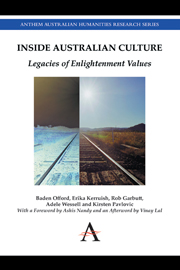Book contents
- Frontmatter
- Contents
- Foreword. Is Australia a Victim of the Ethical Limits of the Enlightenment? A Modest Foreword for an Immodest Venture
- Preface and Acknowledgements
- Chapter One Introduction
- Part One Getting Inside Australian Public Culture
- Part Two Three Moments of the Enlightenment
- Chapter Four Moment One. An Act to Regulate Chinese Immigration (1858): Celestial Migrations
- Chapter Five Moment Two. Cubillo v. the Commonwealth (2000): The ‘History Defence’ – Standards of the Time
- Chapter Six Moment Three. Australian Localism and zthe Cronulla Riot (2005): The ‘Barbaric Law’ of ‘He Who Was There First’
- Part Three Working with the Necessary Other
- Afterword. The Emptiness Within and Without: Enlightenment Australia and Its Demons
- Notes
- Index
Chapter Six - Moment Three. Australian Localism and zthe Cronulla Riot (2005): The ‘Barbaric Law’ of ‘He Who Was There First’
from Part Two - Three Moments of the Enlightenment
Published online by Cambridge University Press: 05 October 2014
- Frontmatter
- Contents
- Foreword. Is Australia a Victim of the Ethical Limits of the Enlightenment? A Modest Foreword for an Immodest Venture
- Preface and Acknowledgements
- Chapter One Introduction
- Part One Getting Inside Australian Public Culture
- Part Two Three Moments of the Enlightenment
- Chapter Four Moment One. An Act to Regulate Chinese Immigration (1858): Celestial Migrations
- Chapter Five Moment Two. Cubillo v. the Commonwealth (2000): The ‘History Defence’ – Standards of the Time
- Chapter Six Moment Three. Australian Localism and zthe Cronulla Riot (2005): The ‘Barbaric Law’ of ‘He Who Was There First’
- Part Three Working with the Necessary Other
- Afterword. The Emptiness Within and Without: Enlightenment Australia and Its Demons
- Notes
- Index
Summary
What the Enlightenment vision prescribes is a kind of ‘minimum norms of civility’ with which you can live. For the immigrant cultures, the Enlightenment vision is less of a threat in the sense that it is what minimally you will expect if a group of strangers – not sharing common values of culture – confront each other. I don't think that this compatibility between immigrant cultures and Enlightenment values has been really taken care of.
Interview with Ashis Nandy, 6 December 2007Introduction
On Sunday, 11 December 2005, Sydney's top-rating primetime news led its bulletin by reporting an event that has provoked reactions that continue to ripple through Australian public life. ‘It started out as a show of numbers by locals wanting to protect Cronulla,’ the report began, ‘but by mid-afternoon it had turned into scenes not seen before in Sydney: angry mobs, fuelled by alcohol, turning on individuals because of their ethnic background.’ The Cronulla Riot, as it became known, was described by the Sydney Morning Herald as ‘Our racist shame’, a bold headline that summarised one response to Anglo-Celtic settler Australians’ abuse and violence directed at Australians of Middle Eastern descent. For others – most notably the prime minister at the time, John Howard – this was a local disturbance with no racial undertones. Nevertheless, the policy response to the Cronulla Riot has been to stimulate national questioning of the efficacy of multiculturalism, especially in relation to the presence of Muslims and people of Middle Eastern appearance in Australian public life and public places.
- Type
- Chapter
- Information
- Inside Australian CultureLegacies of Enlightenment Values, pp. 79 - 94Publisher: Anthem PressPrint publication year: 2014



